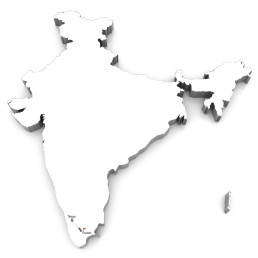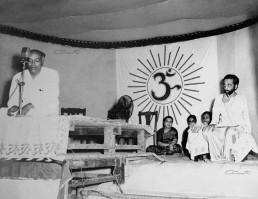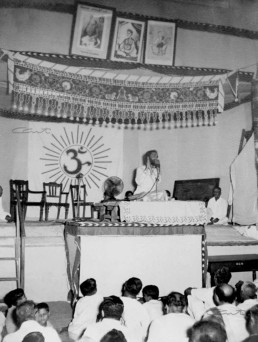
Jnana Yajna 69

Year & Dates:
April 17, 1960 to May 08, 1960

Yajna Topic:
Shrimad Bhagavad Gita- Chapter 3

Place:
Tirunelveli, India.
The skies over Tirunelveli seemed to have watched the excitement of a grand, bright, and artistic pandal springing up in the huge quadrangle of the M. D. T College High School. From the carefully planned car parking facilities to the thoughtfully decorated dais, the thrill of Pujya Gurudev’s Gita Jnana Yajna seemed to have woken up the heavy clouds. So, on the evening of April 17, 1960, just before the inaugural ceremony, a rainstorm accessorized with thunder and lightning decided on its own opening act. The result drenched the carefully sanded floor of the yajnashala, leaving no time for the agonized organizers to find an alternative seating plan. Calm and cheerful, Pujya Gurudev inspected the pandal, invoked the Grace of Bhagavan Shiva at the Nellaiappar temple, and observed the Om flag open up against the rumbling horizon. When Sri I.A. Chidambaram Pillai, the president of the yajna committee, began his welcome address, he was surprised to notice the fully packed audience inside the soaked pandal.
Doing with Dynamic Dedication
Warmed and inspired by Pujya Gurudev’s introductory talk that evening, the audience forgot the discomfort of sitting on the wet grounds. When they heard the promised blessings of Bhagavad Gita from the Master, they were drawn into a higher spiritual orbit where they would be energized for the next 21 days.
Pujya Gurudev declared how Bhagavad Gita was a forever relevant, divine exposition on a vital, vibrant technique of living. He eloquently sketched the background of the Gita where the Divine Charioteer becomes the skillful boatman, Keshava, to ferry Arjuna out of his stormy confusions. In His inimitable style, using the language of commonplace life, He effortlessly took the listeners of all backgrounds to the highest common factor of cooperative action, motivated production, and shared growth as advocated in Karma Yoga. He stressed that work is worship, and alerted the attentive audience how actions get tainted by anxiety, fear, attachment, and selfish motives.
Pujya Gurudev’s sheer logic and poetic power of expression stimulated the aspirants to examine how the two enemies of desire and anger cause havoc, sway the senses, cloud the mind, and render the intellect ineffective. His Jnana Ganga in Tirunelveli was in spate, cleansing the outlook of thousands who came with faith and fervor. The Gita in the evenings and His Upanishad classes in the mornings inundated the temple town with surging spirituality.
To ensure that both Jnana and Karma are always divinized, Pujya Gurudev arranged for the powerful Laksharchana on May 1, 1960. The yajnashala was transformed into a resplendent altar of Bhagavan Krishna as people streamed in all day offering flowers through ten rounds of the Sahasranama chanting by ten pandits. Pujya Gurudev explained how the ten pandits represented the ten senses. He described the intricate meaning behind offering offers during archana: “Watch the hand when it picks up flowers. The fingers are brought together, and they face down. How clearly and perfectly this posture symbolizes the human mistake of gathering vasanas – the senses collect and go downward, and the personalities fall. When they face upward, the vasanas are thrown out; thereby, ‘exhausting’(vasanas) becomes easy and possible.”
Though His body had to submit to a high fever for a couple of days, Pujya Gurudev concluded the 69th Jnana Yajna on May 8th with unabated dynamism personifying how the highest form of action is a liberating art and an indisputable science.
Photo Gallery

“Think,” Says Pujya Gurudev
The whole world of cosmic powers and nature’s phenomena function instinctively in the service of all. Even before life could appear on the face of the earth, the elemental forces had prepared the field with their constant activities performed in the sacred spirit of dedication. Even when life developed and multiplied, at all levels, we can easily recognise different degrees of Yajna-activities, which keep up the harmonious growth of existence.
Poetically the same idea becomes this pregnant stanza in the Geeta. The Creator created the world along with the spirit of service and the capacity for sacrifice. As it were, the Creator declared, “By this spirit of self-sacrifice shall you multiply: this shall be the milch-cow of your desires.” Kamadhenu is a mythological cow supposed to have belonged to Sage Vashishta from which all our desires can be milked out. The term, therefore, means only that no achievement is impossible for man if he knows how to act in the discipline of cooperation, and if he is ready to bring forth into his activities the required amount of non-attachment and spirit of sacrifice.
From Tyagi Magazine
Why are you born Human?
Human existence is shaped by vasanas, determining our experiences and environments. Understanding this, one can accept both suffering and happiness without egoic attachment, recognizing the unfolding of vasanas as the essence of life’s journey. Surrendering to this understanding frees one from the illusion of personal agency.




